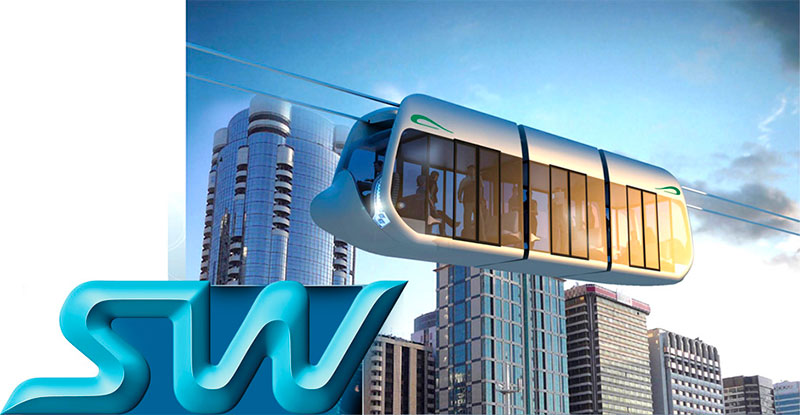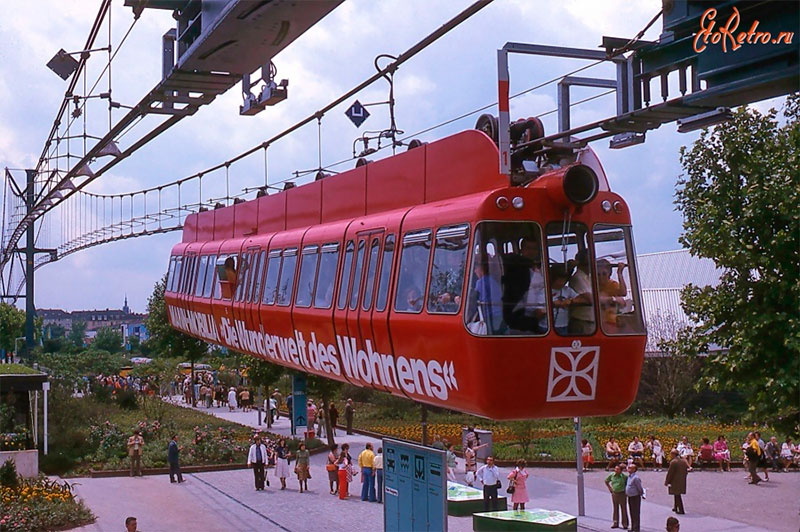
Unitsky String Technologies


 |
Unitsky String Technologies |


|
Site news
|
6 September 2015 |
|
Comparison of SkyWay with OPNV-Aerobus suspension system 
Suspended monorail routes for transportation of passengers and cargo are known in the world for a long time, and Anatoly Yunitskiy is not a pioneer in this field. For example, an elevated transport system in the city of Wuppertal (Germany) was launched into operation on 1 March 1901. As a transport system that is similar to one of embodiments of Yunitskiy city suspended transport complex, also noted can be the city suspended system of trestle type OPNV-Aerobus by a Swiss engineer Gerhard Mueller. 
This system was built for demonstration purposes in the framework of the project "German Federal garden exhibition 1975". The exhibition was held in Mannheim from April 18 till October 19, 1975 on the territory of two parks. A suspended double-track route with a length of 3.1 km connected these two parks. During the exhibition, the route transported more than 2 million passengers. Transport railcars moved along the rail, made of aluminum alloy "avial". The rail was suspended on a pre-stressed bearing cable of 52 mm diameter, which, in its turn, was suspended on pylons (poles). The design of the track is similar to hanging bridges (one of the most famous is the Golden Gate Bridge in San Francisco). After the exhibition, the monorail route was dismantled, as it was planned. Unfortunately, it can be stated that during the demonstration operation, Mueller's system has not found a customer who would want to order its construction for a particular targeted project. Probably, such situation has developed due to the fact that the transport system at that time was ahead of its time and was too innovative, and the cities have not experienced serious traffic problems, so the city authorities preferred traditional "clear and easy" tram or bus. To understand this fact one can look at the statistics of car production in the world from 1970 to 2012 (see table). 
The table shows that production of cars in 2012, compared to 1970, grew up by 2.8 times. Accordingly, now the transport problems in cities are much more serious than those observed in 1975, and, to be sure of that, it is sufficient for a resident of a big city just to look out of the window. As for borrowing Mueller's ideas by Yunitskiy, then, frankly, the similarity of the systems in only one - the wheel rolls on the rail, not on the cable, as, for example, in the way of the firm Neyrpic (the Netherlands, from 1963 till 1965). Mueller himself borrowed the general principle of his transport route from suspension bridges. Well, and another example of borrowing successful design solutions - the Kalashnikov assault rifle (AK-47), which gained the whole world. As it is known, by the results of a test competition, the first AK-47 variant was condemned as unserviceable, however, Kalashnikov got permission for the revision of the weapon. Back in the town of Kovrov, Kalashnikov along with the designer of plant No. 2 Zaitsev, at no time have actually developed a new weapon. By a number of features it can be concluded that his design widely used elements (including the device key nodes), borrowed from other samples submitted for the contest or just pre-existing ones. Thus, the design of the lock frame with a rigidly attached gas piston, the overall layout of the barrel receiver and arrangement of the recoil spring with the guide lug, which was used for locking the lid of the receiver, were copied from the test sub-machine gun of Bulkin, who has also participated in the contest. The trigger could be "borrowed" from the Holek rifle (according to another version it is based on the design of John Browning that was used in the M1 Garand rifle). The lever of the safety lock-fire mode controller, which also served as a dust cover for a breechblock, is very reminiscent of that in rifle Remington 8, and similar "hanging" of the bolt inside the receiver with minimal friction areas and large gaps was characteristic for the Sudaev's sub-machine gun. Used from StG-44 was an intermediate cartridge, from TKB-415 - some specific features of design and technological arrangement of many parts, with the exception of the breech mechanism. It is worth noting that Kalashnikov and Zaitsev managed, "not inventing the wheel", to create a successful design in the shortest possible time by connecting together the borrowed successful separate technical solutions that turned out very effective. On the next round of the competition Kalashnikov provided practically new sub-machine gun, which had little in common with the first variant. As a result of testing, the choice of the Commission was in favor of Kalashnikov's sample. To date, AK modifications make up 1/5 of the total small arms available on the planet, and it was produced in more than 70 million copies. The Kalashnikov's weapon is used even in symbolism of some of the countries - on national emblems and flags. As they say, comments are superfluous, as well as the question: "Who is actually the author of the Kalashnikov assault rifle?" Anyway, let us get back to the comparison of transport systems of engineer Mueller and engineer Yunitskiy. The use of the rolling pair "cylindrical steel wheel - flat head of steel rail" by Yunitskiy provides several times lower resistance to wheel rolling and much more durable route, unlike the aluminum Mueller's rail with the wheel restring on the rail head. Mueller's railcars had absolutely non-aerodynamic shape (however, at speeds less than 40 km/h it does not play a significant role). Yet, if we are talking about high-speed urban transport, speed can reach 120 km/h and more on the line, and aerodynamics here already plays a significant role - up to 80% of the energy is spent on "repulsion" of air at these speeds. Regarding aerodynamics, Yunitskiy's transport system is again by 7-8 times better. For example, the drag coefficient at unibus is Cx=0.08...0.09 (experimental data), and for Mueller's railcars, like for other railroad carriages and buses, it is Cx=0.6...0.7. At the same time, we do not in any way want to belittle the benefits of engineer Mueller's systems - for his time it was an innovative breakthrough project, decades ahead of that time. By the way, about charges of plagiarism. Can anyone blame the companies Chevrolet, Citroën, Fiat, Ford, General Motors, Iveco, Lotus Cars, Nissan, PSA Peugeot Citroën, Shelby Super Cars, Tesla Motors, Toyota and many other manufacturers of electric vehicles in the fact that they stole the idea from Englishman Robert Davidson, who has built the first such vehicle 178 years ago - back in 1837? |
|
© 1977—2017 Anatoly Yunitskiy. All Rights Reserved. |
||